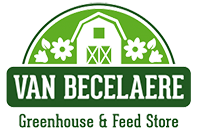Planting Season is Upon the Four-State Region

Posted on April 24, 2023 by Van Becelaere Greenhouse
It is nearly May, and planting season is in full swing here in the four-state region. If you love gardening, you know April and May are peak months for planting. But if you’re new in the area or just picking up the craft, planting can be tricky.
Many factors go into growing a garden. However, the preparation alone can be a daunting task with all the purchases you have to make for tools, equipment, and supplies. Your first step will be thinking about where you live in the United States.
For those living in the four-state area of Arkansas, Kansas, Missouri, and Oklahoma, that means warm days and plenty of full Sun. But anyone that might be curious about our growing season in our region should start by understanding when it’s best to panting, what will thrive, and what will not.
Plant Hardiness Zone for the Four-State Region
Most people, especially farmers, and many homeowners, are familiar with the Farmers’ Almanac, while many Americans know about the United States Department of Agriculture, USDA. But the distinction between the two organizations and their respective guidelines on planting haven’t always aligned.
The Farmers’ Almanac is a trusted source for “gardening by the moon.” A concept passed down from generation to generation by family farmers. It’s a simple practice whereby planting and harvesting follow the Moon’s waxing and waning phases.
According to the USDA’s guidelines for planting and harvesting, the Moon takes no place in their planting recommendations. The USDA Plant Hardiness Zone Map (PHZM) abides by the “average annual extreme minimum temperature over a historical 30-year period.”
So if you live in Joplin, Missouri, and Fayetteville-Springdale, Arkansas, the zone is the same, Zone 6B. But since zones follow annual minimum temperatures, each can divide into subzones of ‘A’ and ‘B,’ indicating which subzones are cooler. Generally, subzone ‘A’ typically stays cooler longer than subzone ‘B.’
That does’t mean you can’t plant something early or later in the season. The USDA’s PHZM can also help you figure out how to develop and nurture a microclimate in your garden too. By building structures to better protect some plants from direct sunlight or protection from prevailing winds.
Get a Head Start on Planting
Now that you know more about your plant hardiness zone, you need to consider a few more things to get a good head start on planting for your garden.
Bedding Plants
Your local garden center is the ideal place to turn when it comes to bedding plants. They will be your regional experts on your planting zone and can give you the most comprehensive list of what is available in their inventory.
Most bedding plants for the four-state planting hardiness zone 6B will be ready for outdoor beds near or after the last frost, such as tomato plants. Whether in Tulsa, Oklahoma, or Joplin, Missouri, popular colorful annual flowers for planting will be your impatiens, moss rose, and petunias.
So stopping by your local garden center near the end of April to the first part of May is a perfect time to pick up those bedding plants in preparation for planting your flower beds.
Planting Vegetables
If you’re hoping for a head start on your garden this season, some vegetables do better before the last freeze, like tubers, cauliflower, kales, lettuce, and spinach. Garden centers and horticulturists do a big part of the work by growing seedlings indoors in March.
Those little seedlings are the perfect little starters to plant in your outdoor vegetable garden around mid-April to early May. Thanks to the master’s of the ‘green-thumb,’ horticulturists have all but figured out the planting dates for novice gardeners.
Your local garden center or greenhouse is well equipped and knowledgeable to answer your planting and gardening questions.
Plan to Visit Your Local Garden Center
The Van Becelaere Greenhouse is a household name for families living in the four-state region. It is a name recognized for its over 40 varieties of tomatoes, synonymous with a stunning array of bedding annuals, and renowned for its Boston Ferns.
If you’ve visited Van Becelaere, you’ve probably met the manager and owner, Jullie Ramage. When she took over the family business, she knew that meant preserving Van Becelaere Greenhouse’s role in serving the local community and loyal customers. She “was not going to increase prices amidst the rising cost of living.”
If you are looking to grab one of those stunning Boston ferns, don’t worry; prices this year are the same as in 2021. What’s more, Julie and her staff are always ready to help you achieve your garden wishes; so if you have the time visit the team at the Van Becelaere Greenhouse & Feed Store today.
